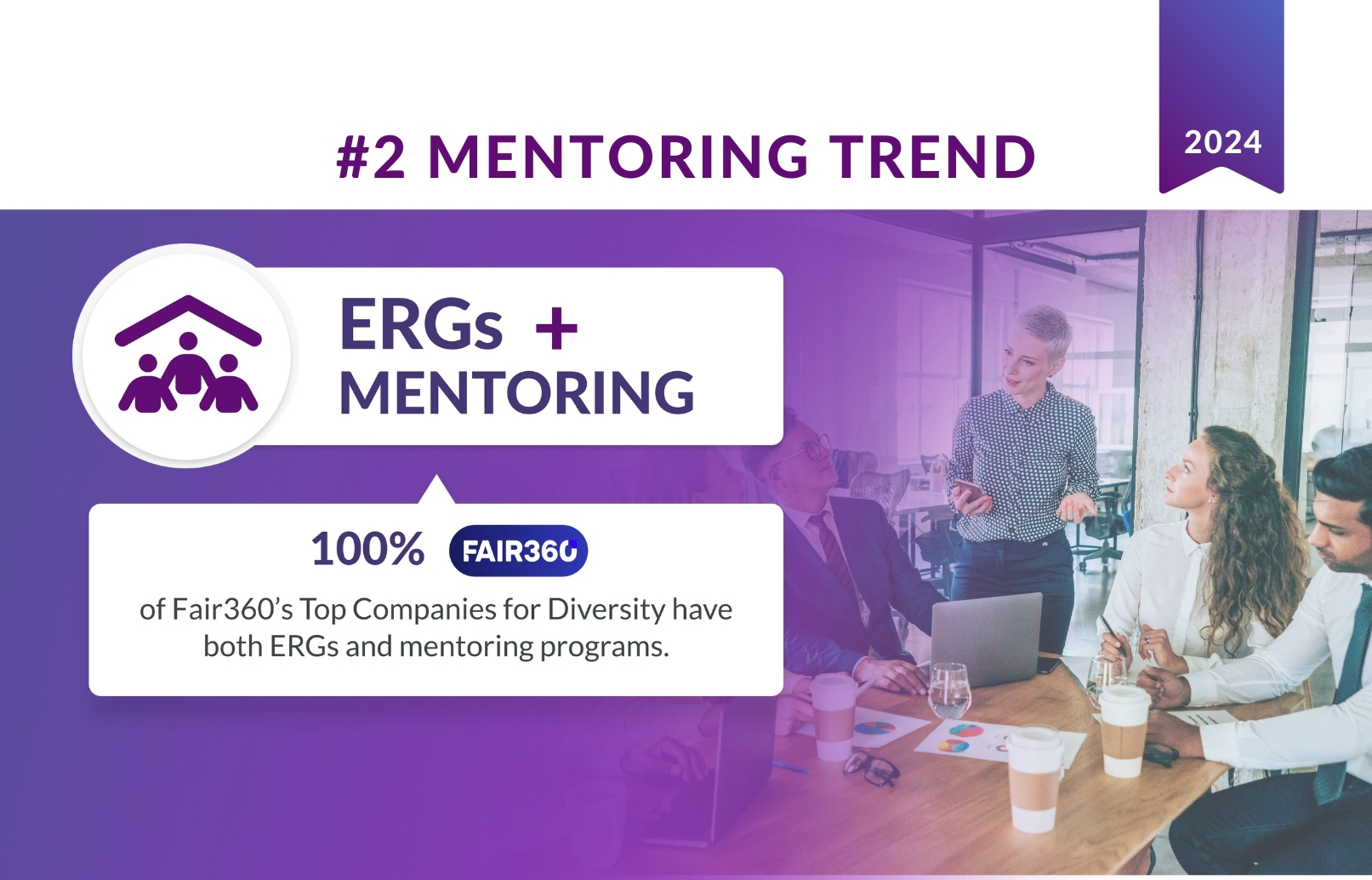As A Great Place to Work astutely observed, “Leaders are missing the promise and the problems of Employee Resource Groups.”
The promise? Strong support for programs that drive community engagement and belonging, company culture, personal and professional development, networking, and DEI goals.
The problems? Broken promises, frustrated ERG leaders and participants, and executives questioning the business impact of their resource groups.
The disconnect often comes down to a big question mark over ensuring ERGs are aligned with business goals and visibly adding value in a way that can be verified with data.
As 2024 progresses, we’re observing a significant trend toward merging mentoring programs (which are already present at 97% of Fortune 500 companies) with ERGs. This approach provides data-driven results that executive leaders want without removing the DEI focus that ERG leaders and participants need.
Why You Need ERGs + Mentoring
Enterprises are zeroing in on how DEI programming can better align with key business goals. That alignment will come from deliberately structured ERGs focused on employee development, engagement, and retention.
In a recent discussion with a Fortune 500 entertainment and media company, a DEI leader explained that while her organization’s Chief Global DEI Officer is primarily concerned with the human impact of ERG programs, the CEO and other executive leaders want to see tangible results. Those results included:
- Retention numbers tied to ERG participation
- The cost-effectiveness of ERG recruitment and training
- A positive ROI from running ERGs
More and more enterprises and their executive leaders are committed to ERGs because of the strong data showing both the positive impact DEI programs have on their bottom line and the fact that their peers continue to support its ever-increasing numbers (and that they must be on to something).
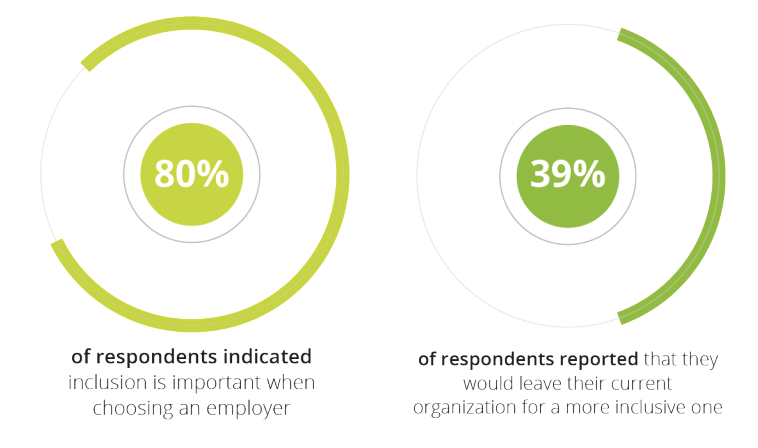
McKinsey found that companies with more diverse leadership teams tended to be more profitable, and according to Deloitte:
- 80% of people want to work for an inclusive company
- 39% would quit for a company that’s more inclusive
- 23% have already taken that action (including 30% of Millennials)
With effective execution, aligning with successful and proven strategies often delivers results. This applies distinctly to DEI, where falling behind the trends carries far more risk than reward.
Are Other Enterprises Also Trying to Get More ROI from Their DEI Initiatives?
Resource Groups come in many shapes, sizes, and especially names. Employee Resource Groups (ERGs), Business Resource Groups (BRGs), and Affinity Groups are the most common. Some organizations get creative with naming conventions, such as my favorite from MentorcliQ client KeyBank, which calls its programs Key Business Impact Networking Groups, or KBINGs.
No matter what companies choose to call them, ERGs and other DEI programs are expanding at organizations of every size, but especially within large companies. At least 90% of Fortune 500 companies and 100% of Fair360’s Top Companies for Diversity offer these programs.
For its part, McKinsey found that 80% of surveyed companies supported ERGs after 2020, up from 45% before that year. That’s nearly twice as many companies supporting ERGs at their organizations post-COVID. The DEI lessons learned from those years were taken to heart and delivered through actionable steps.
Take note: This means ERGs are catching on at enterprises outside the Fortune 500. Remember, we already mentioned that 90% of Fortune 500 companies and 100% of Fair360 companies have ERGs. That means the increased support for ERGs that McKinsey measured is coming from everyone else.
That’s unsurprising, given how common DEI committees (DEICs) have become. According to The Rise Journey, 90% of companies with between 1,001 and 5,000 employees have DEICs. Over 70% of companies with 5,001 to 10,000+ employees also have DEICs.
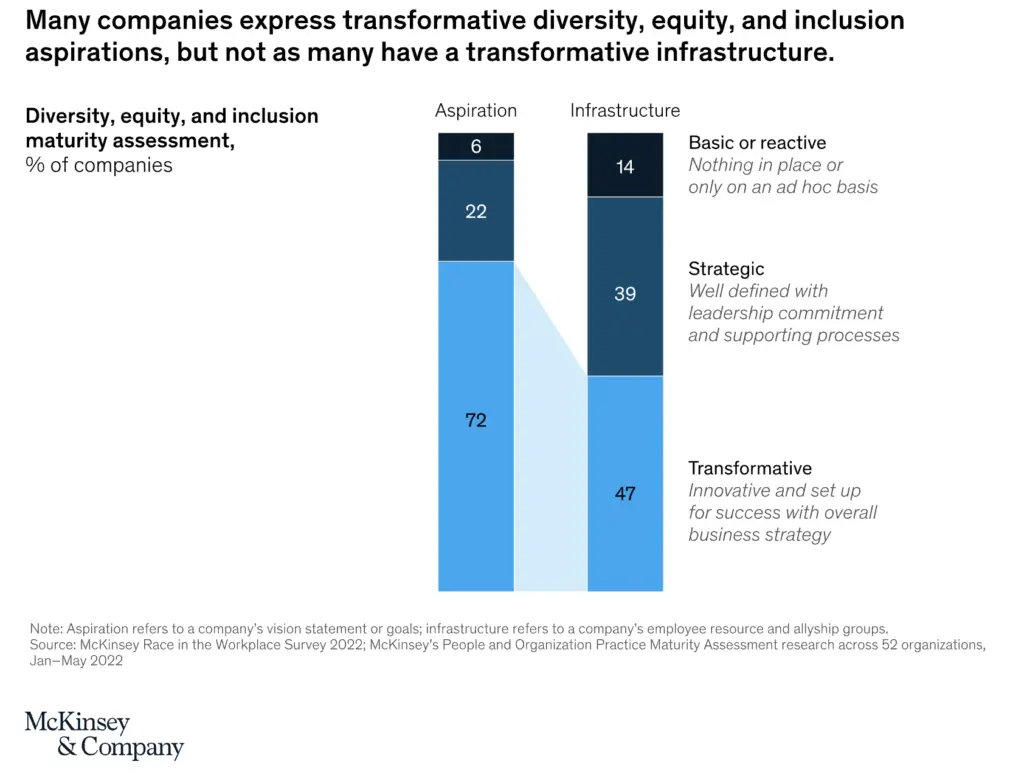
The data here is clear. Both DEI and ERGs are not just alive and well within enterprise businesses; their footprint is growing.
As noted earlier, the most significant disconnect companies are experiencing is with structure and support. Adding these in a strategic way creates an environment where ERGs become the data-driven and business-aligned DEI powerhouses they’re meant to be.
The problem starts (or persists) when those broad aspirations companies establish for DEI programs like ERGS don’t materialize into functional and measurable infrastructure. 72% of companies have big plans for their diversity, equity, and inclusion goals, yet only 47% have turned that aspiration into something tangible.
When it comes to DEI, 53% of companies are stuck in strategy mode or reaction mode. Neither will help deliver desired outcomes to the business in a way that structured and sustained infrastructure for your programs will.
How Will ERGs + Mentoring Deliver Business-Aligned Results?
Multiple data sources show that Employee Resource Groups and mentoring programs are two of the most common employee engagement and development tools enterprises leverage.
Both ERGs and mentoring are heavily present within top revenue-generating companies. While 90% of Fortune 500 companies have ERGs, 97% of them have mentoring programs (based on MentorcliQ’s independent research and unique visibility as a market leader).
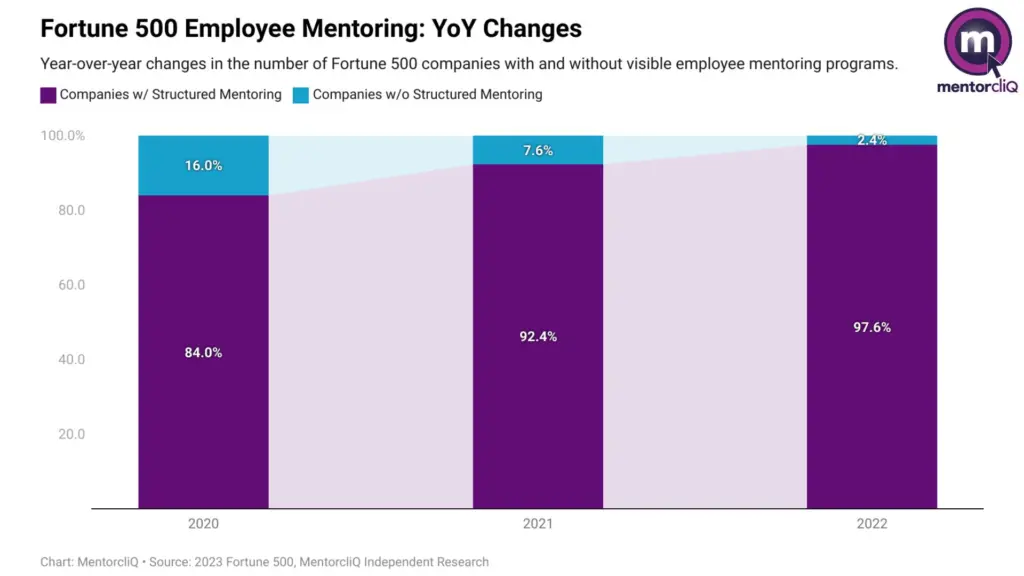
These program types are considered critical for companies dedicated to engagement, development, retention, networking, fostering relationships, and centering DEIB.
Emerging trends point to a significant change that can be summed up in three key points:
- Both mentoring programs and ERGs have distinct populations often siloed between different platforms.
- Merging platforms for ERGs and mentoring allows companies to leverage a single tool to create highly personalized development and engagement opportunities that directly address DEI goals.
- Doing so seamlessly expands the data landscape in a way that allows companies to see the true impact that ERG participation and DEI programming has on critical metrics, such as retention, promotions, engagement, and job satisfaction.
In 2024, we will see a groundswell of companies beginning to marry these two program types in a way that efficiently meets the needs of ERG members, aligns with company goals and objectives, and is significantly backed by data that proves the continuing value and position of ERGs and DEI within an enterprise setting.
We’re also likely to see far more conversations around single-purpose DEI software, including phrases like “What else can it do?” That “what else” will need to be something HR and DEI leaders already recognize as having:
- A proven track record for results
- A structure that can leverage existing knowledge silos
- The functionality to integrate painlessly within existing DEI strategies
Simply put, these conversations will revolve around getting far more functionality out DEI software in a way that few tools currently provide. The ERG + Mentoring pairing will ultimately become a must-have solution for this emerging need.
ESPN’s ERGs + Mentoring Success Story
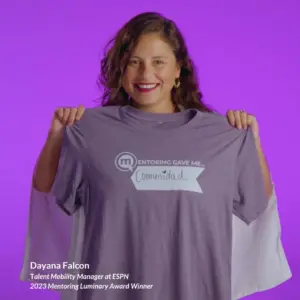
ESPN’s Talent Mobility Manager, Dayana Falcon, launched Peer Mentorship at ESPN with the objective of igniting a culture of career where career meets community. Run through ESPN’s award-winning Career Center, the program is specifically for members of the Business Employee Resource Groups (BERGs) and focuses on three pillars:
- Wellbeing
- Career development
- Inclusion
Designed as a group mentoring program, each cohort consists of one mentor and five mentees who are matched using SMART match in MentorcliQ. The program is a six-month experience, with participants meeting once a month for a curriculum-based agenda that addresses the following:
- Building relationships
- Setting goals across the three pillars
- Learning about the business (includes guest speakers)
- Developing a personal brand
- Identifying transferable skills
- Creating a feedback and sponsorship experience for participants
“I didn’t want this program to be something where advice was only given in one direction: from the mentor to the mentees. I wanted it to be a sense of community where everybody was coming together to reach what they wanted to impact in our company,” said Dayana.
Design Tips
Participants have to be a member of one of the BERGs at ESPN in order to be able to join the Peer Mentorship program. This purposeful design decision ties in with the goal of creating intersectionality and community across all the dimensions of diversity.
One preference question that participants answer helps drive this even further:
- Do you want to be paired in the dimension of diversity that you associate with or that you’re an ally of?
SMART Match forms the cohorts for this program and helps people from across diverse populations come together, find their tribe, and thrive.
Results
The Peer Mentorship at ESPN launched in 2021 and has recorded 5,500 mentoring hours since then. Participants have rated the program with 4.6 out of 5 stars for both the program and relationship experience.

“There’s power in the we. Participants not only feel seen, but they feel like they are a part of something bigger, which then inspires them to take what they’ve learned and experienced and apply that on the job. So it’s unlocking business value tenfold because of the relationships it builds and how we connect the dots. For me, that’s the proudest thing that I have in seeing how this program’s impacted the lives of our incredible talent at ESPN,” said Dayana.
Take it with you:
Download the full ESPN Case Study
ERGs + Mentoring Is As Easy as 1-2-3
The beauty of creating an approach that leverages ERGs with a mentoring component is that it’s one of the easiest trends to follow. A quick internal assessment will help you determine whether this approach is not only viable but also how quickly you can adopt it:
- Review your ERG landscape. How many ERGs does your company have? What tools or services are you using to manage them?
- Review your mentoring landscape. Is mentoring at your company currently visible and structured? If so, what tools exist that support its biggest needs, including matching and participant engagement?
- Assess executive alignment. Is your executive team dedicated to DEI? Are they asking for more tangible, data-backed evidence that DEI is working?
Here’s the beauty of the ERG+Mentoring strategy: You only need 2/3 in any combination. Have ERGS and Mentoring? Perfect; you can launch rapidly with a simple adoption of new software. Have executive alignment and support for DEI and ERGs? Buy-in for making ERGs more actionable with a mentoring component will be an easy sell.
Economic conditions have made everyone hyper-focused on getting more value from their engagement, development, and DEI programs. By aligning your ERG and mentoring programs together, companies will solve two of their biggest problems with a single solution, all while having the data that proves why DEI remains necessary in 2024.



